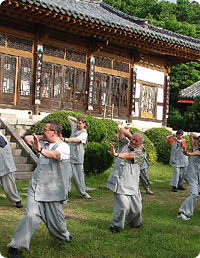SPECIAL INTEREST
Culture Discovery 10 days
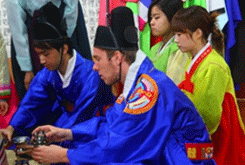
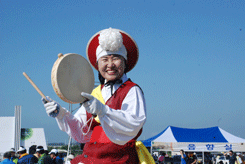
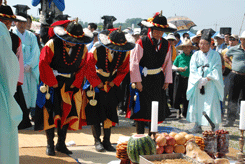
Tour Highlights
- Gyeongbokgung Palace
- National Folk Museum of Korea
- Insadong
- Gyeongdong Herb Market
- Cultural Experience
- Daein Art Market
- Yangrim-dong History and Culture Village
- Tea Plantation
- Nagan Fortress Village
- Hwaeomsa Temple
- Gwanghallu Pavilion
- Jeonju Hanok Village
- Jeongrimsa Pagoda
- Buyeo National Museum
- Busosan Fortress
- Nakhwaam bluff
- Temple Stay
- Oeammaeul Village
- Hwaseong Fortress
Click on the days to access the programs quick
| Days | Visits and Activities | Distance |
| Day 1 | Arrive Seoul | 60km |
| Day 2 | Seoul | |
| Day 3 | Seoul - Gwangju | 290km |
| Day 4 | Gwangju | |
| Day 5 | Gwangju | |
| Day 6 | Gwangju - Boseong - Nagan - Suncheon | 140km |
| Day 7 | Suncheon - Gurye - Namwon - Jeonju | 140km |
| Day 8 | Jeonju - Buyeo - Gongju | 140km |
| Day 9 | Gongju - Asan - Suwon - Seoul | 150km |
| Day 10 | Departure | 60km |
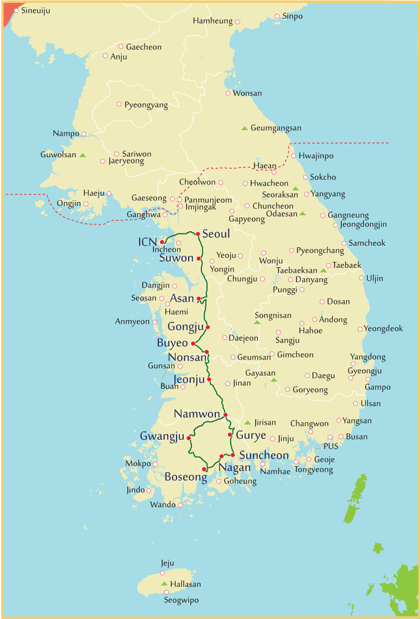 Day 1 Arrive Seoul (- - -)
Day 1 Arrive Seoul (- - -)
60km
Touching down at Incheon International Airport places you in the heart of Korea. After you clear Passport and Customs control, you will be welcomed by the tour guide and then transferred to your hotel.
Day 2 Seoul (B)
Your exploration this morning begins with a driving tour of Seoul, featuring sites such as Seoul Plaza, City Hall, Cheonggye Square and pedestrian-friendly Gwanghwamun Plaza that is hemmed in on three sides by rushing traffic. The plaza is lined on each side with 365m long streamlets, two centimeters deep and one meter across, the stone bed of the plaza's east side waterway engraved with important events in chronological order from 1392 to 2008.
Standing high on a stone pillar is a statue of Yi Sunsin who had engaged in twenty-three naval battles and emerged victorious in all of them during the Hideyoshi invasion (1592-1598). King Sejong who propagated the Korean alphabet in the 15th century is also honored with prominent statue. On August 16, 2014, Pope Francis celebrated Mass in this plaza to beatify 124 Korean martyrs. Near the southwest corner of the plaza is Korea's Kilometer Zero, marking the distances to 64 cities around the world, including Seoul's antipode, Montevideo, Uruguay, 19,606km.
Step back in time to when life was gracefully slow and discover Gyeongbokgung Palace, a particularly charming spot that represents a colorful and turbulent side of the capital's 500-year history. Depending on timing, you may witness the Royal Guard Changing Ceremony featuring parade, password verification, duty shift and patrolling the gate. Accompanied by a court band with its colorful costumes and royal flags, the ceremony is performed daily basis at 10:00 and 14:00 except Tuesdays, although it is cancelled in case of rain or extremely hot or cold weather.
Up from the gates is a spacious stone-paved courtyard that is fully enclosed by wooden cloisters, and at the center of which runs three footpaths through two rows of rank stones, indicating the positions of the officials with the highest rank being closer to the hall.
Standing majestically on top of a two-tiered stone platform that is lined with detailed balustrades is Geunjeongjeon Hall, where the king formally granted audiences to his officials, gave declarations of national importance, presided over large official functions, and greeted foreign envoys and ambassadors. Check out the royal throne and a large painting, depicting sun, moon, five peaks, streams and pine trees, which was the crucial signifier of the king. And up in the center of the ceiling, the bright golden dragons in bold relief indicate the presence of the king.
At the back of the throne hall is a group of court offices. Displayed in front of the King's official quarters is sundial, conceived in order to catch the shadow of the sun, which tells time and 24 periods of seasonal change from the winter solstice to the summer solstice.
Sitting on the island in the rectangular lake is Gyeonghoeru. Supported by 48 square and cylindrical massive stone pillars representing the idea of Yin and Yang, this magnificent pavilion was used for many purposes ranging from receptions to national examinations.
Gangnyeongjeon is the king's sleeping and living quarters while Gyotaejeon is the queen's domain containing a number of halls. The noted feature of these main buildings is an absence of a top roof ridge.
Amisan Garden, landscaped with four hexagonal chimneys in orange bricks, is seldom noticed by the hurried visitors. Jagyeongjeon is the queen dowager's residence. Although less colorful, it is worth noting the wall, adorned with floral designs and the chimneys with ten longevity symbols.
Hyangwonjeong features a small pond with a manmade islet that supports a beautiful two-story pavilion. Behind this serene garden is Geoncheonggung, where the king and queen could relax in peace and quiet. It was here that the first electric lights in the country were installed in 1887 after 8 years of Thomas Edison's invention and a tragic chapter in Korea's history was recorded when empress Myeongseong was assassinated by the sword-bearing Japanese assassins in the early morning of 8 October 1895, allegedly under orders from Miura Goro.
Your visit to the National Folk Museum of Korea will familiarize you with wealthy culture of this friendly and picturesque nation. It is an excellent facility to illustrate the history of traditional life of the Korean people from the prehistoric age to the Joseon dynasty. The permanent exhibition features life and work, costumes and ornaments, handicrafts and technology, educations, living quarters, dietary life, oriental medicine, performing arts and games, beliefs and rituals, and
socio cultural life.
Insadong, at one time the center of traditional Korean art and antiques, features a mixture of historical and modern atmosphere representing the cultural glimpse of the nation. Clustered along the main street and alleys are lined with street vendors, wooden tea houses, restaurants and numerous galleries and shops dealing in antiques, oriental art supplies, and modern Korean art of all types and styles. Soak in the paintings, upscale artworks, antiques and potteries while you can. Get lucky and you just might meet the artist themselves. It can be plenty of fun walking on the main street, but you venture into the hidden alleys that do spring some unexpected surprises. While here, you may want to buy some souvenirs or simply wander and browse at leisure admiring cultural ambience.
You will tour the Gyeongdong herb market which is one of the largest herbal medicine markets in Korea. There are more than one thousand pharmaceutical stores, oriental health clinics and herbal drugstores selling various Asian medicines, ginseng, spices, herbs and roots. What's more, there are lots of things that may not be familiar to the eyes of foreigners, but most of them can be sampled. The atmosphere is filled with the rich fragrance of raw medicinal products. Stroll down the market and take a deep breath, you will immediately feel more rejuvenated and relaxed.
Day 3 Seoul - Gwangju (B) 290km
Morning is spent for travelling to Gwangju. More known for the Gwangju Uprising, a series of democratization movements that swept the city in May, 1980. The independent spirit has lent itself to art, and reputation of Gwangju for artistic creativity is represented by Gwangju Biennale and Gwangju Design Biennale, biannual art festival which are regarded as the World's top 5 international art festivals enjoyed by visitors.
Afternoon program includes Gwangju Confucian School for an introduction of Korean traditional manners, etiquettes and wedding ceremony demonstration. Although active Confucianism as a form of religion is almost extinct, many of its rituals and customs are interwoven with the Korean way of life, ideology and social etiquette.
In Korea marriage is not just about two individual getting married, rather emphasized as joining of the two families, joining to heaven and earth, as well as wishing for good harmony between Ying and Yang.
The wedding ceremony begins with public announcement followed by candle lighting. Bride's and groom's mothers would enter the wedding place and light candles whose flames represent the wish of the new couple's bright future with passion.
Then, the solemn yet rather complicated wedding procedure goes with wild geese and groom's parade, presentation of wild geese, bride's parade, presence at the nuptial table, bowing ceremony, drinking and announcing the marriage to the heaven, weaving red and blue threads, receiving wild geese, letter reading and bowing to the parents and guests, and finally Paebaek.
After the wedding, the bride and groom immediately meet their new parents-in law in an area of the main living room and bow to them to show their respect to groom's family and ancestors. Groom's mother would throw some nuts to both bride and groom hoping for grand children.
Try on Korean traditional costumes and enjoy Korean green tea. Although a short program, you will be profoundly impressed at the subtle touch of the Korean culture.
Day 4 Gwangju (B)
Morning is planned at Korean Alphabet or Hanguel Learning in one of the universities. The learning program is based on the beginners.
Korean alphabet, Hangeul, was invented in 1443 by King Sejong. Hangeul has 24 basic letters of 10 vowels and 14 consonants. The Hangeul is vertically and horizontally symmetrical and systematic in sound by adopting the ligature principle, which is adding lines to strengthen the sound and combining consonants and vowels. The form of each consonant is based on the shape of the vocal organs used to produce them. The program is based on those who wish to learn Hangeul for the first time. The basics of the Korean script can be learned in a matter of hours. Learning Hangul is a joy. You might be so motivated that you will never quit Korean. The finer points of pronunciation, however, and spacing can take years.
Explore Daein Art Market. The stagnant traditional market was revived and became a culture-art market. The wide assortment of art displays are distributed throughout the market, a unique place of shopping for fresh groceries and goods delivered directly from the source. Near by Daein Art Market, there is a well-known street as modern art space. There are many small galleries, cafes, antiques stores, small theaters, drawing rooms, and Chinese art supply stores in the Street of Arts. Gwangju's Street of Art is a place capable of feeling and smelling on traditional culture in the heart of the city. In particular, an old book store has lyrics, prose collections, and collections of family trees.
Explore Yangrim-dong showcasing a modern history of Gwangju. The area is marked by the first entry of western missionaries. Old churches, schools, hospital and residences inhibited by the missionaries still remain intact. As you walk through narrow alleys, you will feel the ambience of the days of a century ago.
Day 5 Gwangju (B)
Day at Hangeul Learning program followed by Kimchi Making.
Kimchi is an absolute necessity in every Korean meal. So thus, a meal without Kimchi is not complete. Enjoy a Kimchi-Making session where you will learn how to make delicious Kimchi. To make Kimchi, you put a mixed stuffing of various vegetables and condiments into the pickled cabbage which was soaked in salt, and spring onion, garlic ginger, and oyster are also used as usual ingredients. After mixing them together, they are put into the spaces between the leaves of a Chinese cabbage evenly and then the whole cabbage is wrapped with the outermost leaf. The cabbage Kimchi is piled in a large earthenware jar for a month. Making Kimchi is not only interesting but an excellent opportunity to understand the Korean culture and dietary life.
Day 6 Gwangju - Boseong - Nagan - Suncheon (B) 140km
Taekwondo Practice is planned in one of the Taekwondo gyms that warmly welcomes those who wish to experience Korean traditional martial art. Taekwondo is a kind of sport and exercise mainly involves hands and feet. It helps you maintain physical and spiritual health through practicing various defense and offense skills. As you get increasingly skilled in Tawkwondo, it also helps boost flexibility, strength, balance, breathe, sights and concentration of spirit in addition to enhanced martial art skills and spirits through Taekwondo's mental discipline.
En route stop at Boseong, known as the home of tea, hemp clothes and Sori or a Korean traditional genre of singing. A number of tea plantations where the carefully trimmed tea trees stretch endlessly over steep mountain slopes - a lush green carpet that is a sight to behold. A short walk along the path lined with cedar trees that had been planted to block the wind leads you to the tea plantation delightfully accommodating visitors. The tea bushes rising in regular curves are great. Here, you will freely roam the hills, walk between the rows of bushes and take pictures of each other at every bend.
Explore Nagan Fortress Village which has survived time and modernization. Entering the village, you could feel as if you have gone back to the centuries past. Surrounded by 1,410-meter long fortress which was built into a mud rampart in the 14th century to repel Japanese pirate raids, the village features nearly 90 traditional thatched roof houses presenting a peculiar townscape in harmony with the rectangular stone rampart. One unusual aspect of the town is that it was inhabited by a number of different clans rather than having one dominant one. Part of the fortress wall arches over the hill and you will today take in a great view of the entire village as well as the traditional housings, cultural landscape, time old customs and rituals representing the agricultural society of Korea while strolling around the small alleyways within the village.
Day 7 Suncheon - Gurye - Namwon - Jeonju (B) 140km
The journey continues to Gurye for a visit to the 6th century Hwaeomsa. The whole atmosphere of the temple is sublime and the wooden structures give it a real earthly feel, very calming. The temple is dedicated to the vairocana Buddha, the cosmic head of the Hwaeom trinity. First, One-Pillar Gate standing at the lower part greets you and leads you up to the second and the third gate - from the secular world into the spiritual world. On the second level, there is the Bojeru, the Save All Beings Hall, beside which stands bell and drum tower. And on its ground stands two magnificent 5-story stone pagodas from Silla period that adorn the temple.
Gakhwangjeon has a double storied roof and houses seven figures on its altar. Sakyamuni Buddha sits in the middle attended by Amitabha and Prabhytaratna, as well as Avalokitesvara, Samantabhadra, Manjusri, and Ksitigarbha. You check out the largest stone lantern on the Korean peninsula that is designated National Treasure out in front of this hall. And up from the left of Gakwhangjeon hall, a steep set 108 uneven stairs on the hillside stands the Three-Story Stone Pagoda supported by four lions each of which represents the four primary human emotions: love, sorrow, anger and joy. Here, you will enjoy the intricacies of this masterpiece as there are numerous other designs etched onto the pagoda.
Next, you will stop off at Namwon, a charming city with many historical sites and tourist attractions. It is also famous as the home of Chunhyang, the faithful maiden whose story has been often compared to the Romeo and Juliet. At the center of the town is a park, in which stands Gwanghallu Pavilion where Chunhyang and her lover are said to have first met, and there is a bridge built on a pond that is supposed to ensure connubial bliss to any couple that steps on it.
Namwon is also known for the home of traditional music. Many famous Pansori, Korean opera, singers are from this small town. A visit to the Namwon Classical Music Institute offers an opportunity to enjoy Korean traditional music including vocal and instrumental music. While there in Namwon, you will have a chance to learn Korean Sori.
Then, on to Jeonju, a city of time-honored tradition as well as significant cultural and artistic heritage.
Jeonju is a time-honored tradition as well as significant cultural and artistic heritage. There's a plenty of history and artifacts of many kinds to go around. You will explore Jeonju Hankok village, a Korean House complex retaining much of their perfection intact. Near the entrance of the complex stands Gyeonggijeon that holds the portrait of founder king of Joseon dynasty, featuring him seated in a magnificent red chair with three gold-foiled dragons on his royal blue robes. And on its front is a beautiful Jeondong Catholic church of Byzantine and Romanesque architectural design. Completed in 1914, it is one of the oldest and largest Western-style buildings in the region. It was designed by master church builder Victor Lousi Poisnel, the Norman priest whose work in Korea includes Myeongdong Cathedral in Seoul. Just west of the church is the stately Pungnammun gate, where three Catholics paid for their religion with martyrdom on December 8, 1791, marking the first time in Korea.
Hat Museum offers a collection of handmade hats and a carefully chosen selection from among the most characteristic styles, providing a wide-angle cultural perspective on what has always been the essential accessory. Some 300 hats are on display ranging from traditional Korean hats such as the Gat, made from bamboo and horse hair, to the modern hunting cap and beret. While not particularly worth visiting on its own, a small traditional wine museum within features a decent exhibition of some traditional Korean alcohols and the processes that created them. Hanji Industry Support Center is a good source of learning traditional Korean paper gaining global recognition.
Day 8 Jeonju - Buyeo - Gongju (B D) 140km
Today, you will explore archaeological sites and ancient historic areas, which were collectively named as a UNESCO World Heritage sites. Gungnamji is the Korea's oldest artificial pond dating back to 634. Ringed by weeping willow trees, it creates a colorful spectacle with its stock of water lotuses in summer. Jeongrimsa temple site with its five-storied stone pagoda recalling the glorious past is one of the city's most distinctive and outstanding landmarks.
At Buyeo National Museum, you will feel the spirit and the essence of the brilliant Baekje culture as you appreciate the beauty of the archaeological relics. A beautiful gilt bronze incense burner is impossible to miss. Crafted over 1,500 years ago, it shows a graceful dignity and the elaborate skills of Baekje craftsmen.
Stroll up paths to Busosan to explore Baekje fortification. At the top of the hill sits Yeongillu pavilion where the king once came to watch the sun rise over his kingdom.
A little further down the trail, you will see a pavilion called Baekhwajeong perched at the top of the rock beside which locates Nakhwaam, literally meaning Falling Flower Rock, on a bluff overlooking the Geum River at the bend called Baekma. As enemies swarmed into the capital, the court ladies flung themselves into the water from this bluff rather than suffer the shame of submitting to atrocities of the conquering enemy armies.
There are many temples in Korea, but the opportunity to observe and experience the ascetic Buddhist life in a temple does not come easily to outsider visitors. Magoksa temple opens its door to foreign visitors for a short sojourn to give visitors the opportunity to see how monks practice their daily discipline from early morning prayers to evening rites. The temples are places where Buddha dwells and where the disciples of Buddha, or monks, practice asceticism. It is also a place where believers learn Buddhist teachings and put them into practice. Visitors will get to study and experience the Korean tradition and culture, all at the same time enjoying the nature.
Temple Stay program may vary due to season and conditions of the individual temple situation but it basically includes morning and evening services - Yebul, 108 prostrations, meditation, tea ceremony, Ulyeok, lotus lantern making or prayer bead making. You will experience temple meal, perhaps first time in your life. The food doesn't have spices and is neither hot nor salty. It is another mysterious experience for the commoners to try. The warm Ondol floors (heated from below) of the temple are clean and large enough to accommodate a small group of visitors. Rooms are sparsely furnished with mattress, quilt and pillow. It is advisable to bring your towel. However, the slight inconvenience is more than compensated by the tranquil and introspective atmosphere of the temple.
Day 9 Gongju - Asan - Suwon - Seoul (B) 150km
Predawn Buddhist Dharma Ceremony. Every monk and people in the temple will gather at the Main Buddha Hall and perform the ceremony. This magnificent Dharma Ceremony will clear all dust from your minds and all stray thoughts from your heads. During the Yebul, you will offer 108 prostrations to the Buddha, along with the monks. By doing this, Buddhists believe that people will be freed from the 108 passions and delusion that disturb and pollute their body and mind. Breakfast - Baru Gongyang or four-bowl meal, is a unique and special dietary arrangement of Buddhism.
Next, explore Oeam Village, one of the traditional clan villages exuding old and rustic charm. The village entrance is marked by stone bridge, pine forest and totem poles. This village with more than 400 years of history has about 70 traditional houses, and is highlighted by 6km-long stonewall paths ringing the village and the amazing artificial water system that goes through the entire village for gardens and agriculture. As you stroll along the pathway, you will see thatched cottages and tile roof houses representing typical village layout of central Korea and at the same time feel the rural ambience and peaceful atmosphere.
While in Suwon, you will explore UNESCO World Heritage site of Hwaseong Fortress from the 18th century. Though it is relatively small in scale, it is well acknowledged as the best structure of its kind ever built in Korea. A 5.74km-long fortress enclosing both flatland and hilly terrain is parapeted with crenels and merlons and highlighted by four main gates and well over 50 structures including temporary palace where the king sought refuge during war and found rest during times of peace. A walk through the whole fortress could take several hours but it is well worth making a short walking tour to enjoy the splendor of the fortress, including the Korea's largest Janganmun Gate.
Day 10 Departure (B) 60km
After this wonderful trip exploring Korea and with time to reflect on your surprise in your experience, you will return to the airport in time for your flight. By boarding, you are already high above Incheon heading for home.





